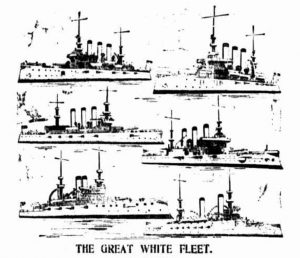[Editor: This article, about the visit of the Great White Fleet (US Navy) to Australia in 1908, was published in The Townsville Daily Bulletin (Townsville, Qld.), 20 August 1908.]
The Great White Fleet.

The entire fighting fleet that left Hampton Roads on 16th December last is shown in the drawing, with allowance for the duplications. The vessels are the Connecticut, Vermont, Louisiana, Minnesota, Georgia, New Jersey, Rhode Island, Virginia, Ohio, Missouri, Nebraska, Wisconsin, Illinois, Kearsage, and Kentucky.
The drawing is not to scale; that is to say while the ships are correctly pictured individually their relative sizes must not be estimated by making comparisons. Thus the Connecticut and Louisiana, twin ships, are of the maximum size, as are the Kansas, Vermont, and Minnesota. Each, according to the “Scientific American,” is of 1600 tons displacement, which is 1600 tons in excess of the displacement of the Powerful, flagship of this station. The Georgia, Virginia, New Jersey and Rhode Island are of 14.948 each; the Ohio, Nebraska and Missouri, of 12,500 each; and the others range down a little more.
To understand this a little more clearly let us indulge in some “kindergarten” comparisons. If the entire sixteen ships were moved in a line, stern to stern and touching, they would cover a distance of 9000 feet, or say a mile and three-quarters. If we had the money the ships cost to build and equip we could do various things with it. In 18ct gold it would give us an ornamental gun boat weighing (not displacing) 600 tons; in standard silver it would give us an ornamental cruiser weighing 9000 tons.
The fleet carries 64 great guns or guns of battle-ship standard. Sixty-four means much or little according to how it is considered, but if all the guns were one gun and all their shots were one shot, and all their force of propulsion could be concentrated into one force of propulsion then the resultant gun would be able to fire a shot a distance of 1000 miles. But the ships carry many other guns — 1080 of them — 6-inchers, 12-pounders, and the like, and if these could be treated in the same way then the fleet could signalise its arrival in our waters by dropping a shell within “splashing” distance of San Francisco.
The fleet cost a mint of money to build, and it costs a mint of money to maintain. Nevertheless we do not desire to exaggerate. Queensland’s gold jubilee has shown us a golden pineapple, worth over £60,000,000; but Australia has, since 1851, produced gold to the value of £522,000,000. Giving a million as the cost of each vessel of the great White Fleet, we see that we could have built a very respectable navy if we had done no more than ear-mark each sovereign’s worth of gold raised with a 6d naval “excise duty.” This would have returned £12,000,000, or not far short of the American fleet’s value.
It is always interesting to have information in this way, as it stays in the mind longer when given in such clear cut form.
Thus, roughly speaking, the fleet is manned by 15,000 men and equipped for a 12 months’ voyage. Consider its supplies, partly shipped when it started, and partly to be got as it goes. Fifteen thousand men means 15,000 meals a day, or 315,000 meals a week; in the year, if they take a year, New York and back, they will eat over 16,000,000 meals, but the ships also eat, and their fuel is coal. Consider the fuel they will burn on this quite unprecedented voyage. Before the original route was altered to accept Australasia’s invitation the coal bought for reconsumption totalled 350,000 tons. This now will be added to considerably.
Source:
The Townsville Daily Bulletin (Townsville, Qld.), 20 August 1908, p. 7
Editor’s notes:
Great White Fleet = the nickname of the US fleet which carried out a world tour from December 1907 to February 1909, as an instrument of goodwill visits and as a demonstration of the power of the US Navy (the hulls of the battleships were painted white, hence the nickname); the fleet visited Australia during August and September 1908
Hampton Roads = a roadstead in southeastern Virginia (USA), being a confluence (junction, or meeting point) of the James, Elizabeth, and Nansemond rivers, adjacent to Chesapeake Bay; originally known as the Earl of Southampton’s Roadstead, named after Henry Wriothesley (1573-1624), the third Earl of Southampton, who was a financial backer of the Virginia Company (which settled Jamestown and other parts of Virginia)
roads = (archaic) (also known as a “roadstead”) a partly-sheltered body of water near a shore, where ships can safely anchor, having a reasonable amount of protection from ocean elements
station = a naval station: a military base for ships; a naval base or port which provides support and shore facilities for ships; a naval command area (e.g. the Australia station of the Royal Navy, 1859-1913)
See: “Australia Station”, Wikipedia
[Editor: The original text has been separated into paragraphs.]
Leave a Reply